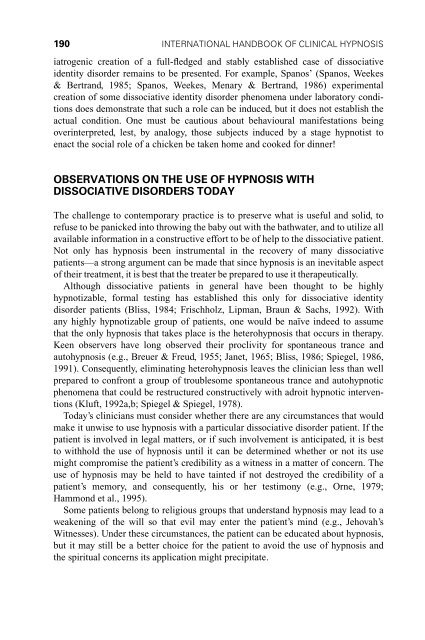International Handbook of Clinical Hypnosis - E-Lib FK UWKS
International Handbook of Clinical Hypnosis - E-Lib FK UWKS
International Handbook of Clinical Hypnosis - E-Lib FK UWKS
You also want an ePaper? Increase the reach of your titles
YUMPU automatically turns print PDFs into web optimized ePapers that Google loves.
190 INTERNATIONAL HANDBOOK OF CLINICAL HYPNOSIS<br />
iatrogenic creation <strong>of</strong> a full-¯edged and stably established case <strong>of</strong> dissociative<br />
identity disorder remains to be presented. For example, Spanos' Spanos, Weekes<br />
& Bertrand, 1985; Spanos, Weekes, Menary & Bertrand, 1986) experimental<br />
creation <strong>of</strong> some dissociative identity disorder phenomena under laboratory conditions<br />
does demonstrate that such a role can be induced, but it does not establish the<br />
actual condition. One must be cautious about behavioural manifestations being<br />
overinterpreted, lest, by analogy, those subjects induced by a stage hypnotist to<br />
enact the social role <strong>of</strong> a chicken be taken home and cooked for dinner!<br />
OBSERVATIONS ON THE USE OF HYPNOSIS WITH<br />
DISSOCIATIVE DISORDERS TODAY<br />
The challenge to contemporary practice is to preserve what is useful and solid, to<br />
refuse to be panicked into throwing the baby out with the bathwater, and to utilize all<br />
available information in a constructive effort to be <strong>of</strong> help to the dissociative patient.<br />
Not only has hypnosis been instrumental in the recovery <strong>of</strong> many dissociative<br />
patientsÐa strong argument can be made that since hypnosis is an inevitable aspect<br />
<strong>of</strong> their treatment, it is best that the treater be prepared to use it therapeutically.<br />
Although dissociative patients in general have been thought to be highly<br />
hypnotizable, formal testing has established this only for dissociative identity<br />
disorder patients Bliss, 1984; Frischholz, Lipman, Braun & Sachs, 1992). With<br />
any highly hypnotizable group <strong>of</strong> patients, one would be naõÈve indeed to assume<br />
that the only hypnosis that takes place is the heterohypnosis that occurs in therapy.<br />
Keen observers have long observed their proclivity for spontaneous trance and<br />
autohypnosis e.g., Breuer & Freud, 1955; Janet, 1965; Bliss, 1986; Spiegel, 1986,<br />
1991). Consequently, eliminating heterohypnosis leaves the clinician less than well<br />
prepared to confront a group <strong>of</strong> troublesome spontaneous trance and autohypnotic<br />
phenomena that could be restructured constructively with adroit hypnotic interventions<br />
Kluft, 1992a,b; Spiegel & Spiegel, 1978).<br />
Today's clinicians must consider whether there are any circumstances that would<br />
make it unwise to use hypnosis with a particular dissociative disorder patient. If the<br />
patient is involved in legal matters, or if such involvement is anticipated, it is best<br />
to withhold the use <strong>of</strong> hypnosis until it can be determined whether or not its use<br />
might compromise the patient's credibility as a witness in a matter <strong>of</strong> concern. The<br />
use <strong>of</strong> hypnosis may be held to have tainted if not destroyed the credibility <strong>of</strong> a<br />
patient's memory, and consequently, his or her testimony e.g., Orne, 1979;<br />
Hammond et al., 1995).<br />
Some patients belong to religious groups that understand hypnosis may lead to a<br />
weakening <strong>of</strong> the will so that evil may enter the patient's mind e.g., Jehovah's<br />
Witnesses). Under these circumstances, the patient can be educated about hypnosis,<br />
but it may still be a better choice for the patient to avoid the use <strong>of</strong> hypnosis and<br />
the spiritual concerns its application might precipitate.











![SISTEM SENSORY [Compatibility Mode].pdf](https://img.yumpu.com/20667975/1/190x245/sistem-sensory-compatibility-modepdf.jpg?quality=85)





